Employees are drowning in the network effects created by the myriad internal and external communications and content channels.The Great Reevaluation is creating such untenable situations for people that they are leaving jobs without first finding another one – even in the U.S. where they risk losing health care. They are doing it against their economic self-interest. They are doing it because they can no longer tolerate their work environment. This reevaluation has been coming for some time; organizations have failed to adapt sufficiently to the changing information environment and the impact is largely left to individuals to absorb.
All the Responsibility And None of the Control
The amount of information and content in the world has accelerated quickly and is so big that it is hard to absorb, never mind process. It is a mind-boggling change in just the last decade and has fundamentally changed our relationship with information. There are so many sources for similar information that it is increasingly difficult to know what to trust. This has played out in devastating ways in civic society but that dynamic is also playing out in every organization which relies on knowledge and innovation.
In 2020, 64.2ZB of data was created or replicated. “The amount of digital data created over the next five years will be greater than twice the amount of data created since the advent of digital storage.
Dave Reinsel, senior vice president, IDC’s Global DataSphere
In some ways, the challenge of navigating this information environment is easy to ignore. Unlike decades ago, when I was helping to literally shred 40 filing cabinets full of outdated confidential information at the Pentagon, we cannot see it – there is no constant, visceral reminder of its phenomenal growth. Yet we are asking individuals to navigate through it.
As information growth has compounded, organizations are buying more and more technology to process, mine, and surface it. It is no wonder there is so much interest in AI – because no human can get through it. However, that has also created an explosive growth in technology and applications that are just as dizzying as the growth in content.
One need look no further than the Marketing Technology Landscape that Scott Brinker has put together annually for a decade to see the change. It is mind-numbing.
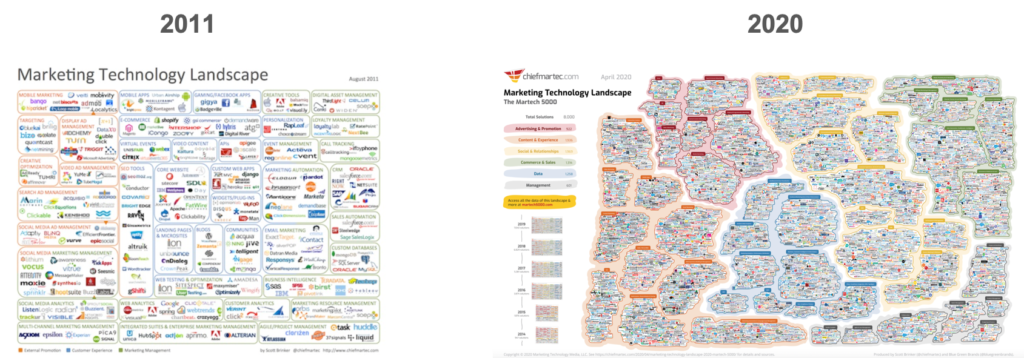
People Are the Weakest Link
In 2011 I keynoted at the Enterprise 2.0 Conference and my message was that people were the weakest link – and that they were breaking. The pressure on individuals, which could be seen in 2011, has dramatically increased. People are suffocating under the weight of unchanging demands and expectations in a vastly more complex work environment. Instead of making life easier, it is driving up anxiety, distrust, and exhaustion while providing little emotional support, energy, or relief. To add insult to injury, they hear executives talk about ‘returning to work’ and feel completely unseen and unappreciated – because they have not only been working, they have been working through a pandemic.
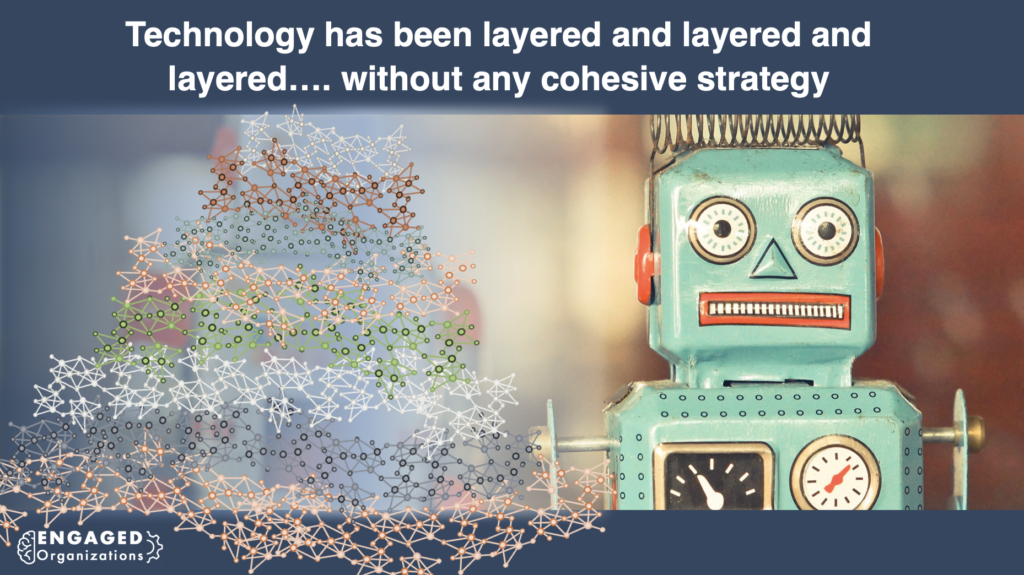
Organizations – operating with yesterday’s governance model and yesterday’s metrics – have done little to change systemically. They are still pursuing outdated, production-era metrics that assume more is more – and organizations continue to produce ever-more content. In a chaotic information environment, however, more is less. More makes identifying trustworthy content harder to find and increases anxiety because it is so hard to process. Any complicated or lengthy message is lost, unable to rise above the cacophony. Because of this content is now only as good as the people who vouch for and recommend it. In a world of too much, people and relationships are the ‘metadata’ that determines the value of content. That trusted connection is what grounds and assures individuals when they don’t know how to evaluate the deluge coming at them from all angles.
Organizational governance and metrics need to be rearchitected to deepen trust and meaning first and deemphasize quantity as the primary measure of progress.
Rachel Happe, Engaged Organizations
A Networked Problem
Every communications channel has a network effect, which essentially means that the more people use it, the more valuable it is. With so many channels to choose from, how do individuals choose? Individuals are left to decide which channels to use and, because of that, the most valuable channel is determined by a popularity contest rather than what is most effective for the work to be done. Without collective decisions about use, individuals are at the mercy of every other individuals’ decisions – so they have to be in ALL the channels if they want to keep up. It is far, far worse than one overflowing email inbox.
It is madness.
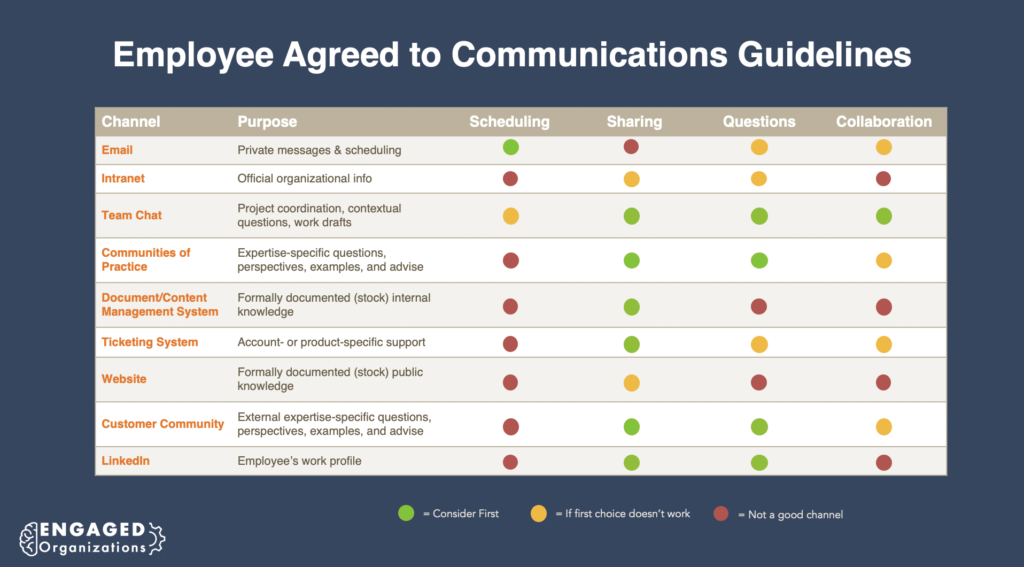
Individuals cannot escape from this quagmire on their own – because they are only one node in the network – and each node is making different decisions about how to communicate. Organizations – not individuals – need to take on responsibility for facilitating the consistent use of an ever-growing number of communications channels. However, organizations have no history or experience in what is required to help their organizations navigate this; IT’s job is to deploy the technology and show people how to use it, KM’s job is to structure and organize content that exists, and communications’ job is to add more content. They all see the problem – but they are only one part of the solution. Networks – whether teams, groups, business units, divisions, or enterprises need to agree on what needs to be consistent at each level – and how each channel is best used. Critically, managers need to support behavior change by encouraging and rewarding consistent behaviors. In groups where work is relatively routine, they may be able to rely on a business application for the majority of their communications. An innovation team will need a much bigger variety of tools because their work is constantly changing. The entire organization may decide there will be no meetings on Fridays.
What Can Executives Do?
Acknowledge the Problem
The most important thing that executives can do is understand and acknowledge the problem. Often, and especially in large organizations, executives are surrounded by other executives and have both assistants and communications partners whose job it is to filter information so they don’t have to see this mess – because it would be hard to be effective if they did. That is great for them but it distances them from what individual employees are experiencing. It is also easy to ignore or dismiss, which is not helped by a popular ethos in executive circles of ‘don’t bring me problems, bring me solutions.’ With that mindset, any complaint can be seen as an individual who has a personal issue or is whining. But this information issue, because of its network effects, cannot be solved by any individual – and there is no one right answer; teams, groups, and the organization as a whole have to collectively decide on and accept what is used for different purposes.
Fund an Enterprise Community Team
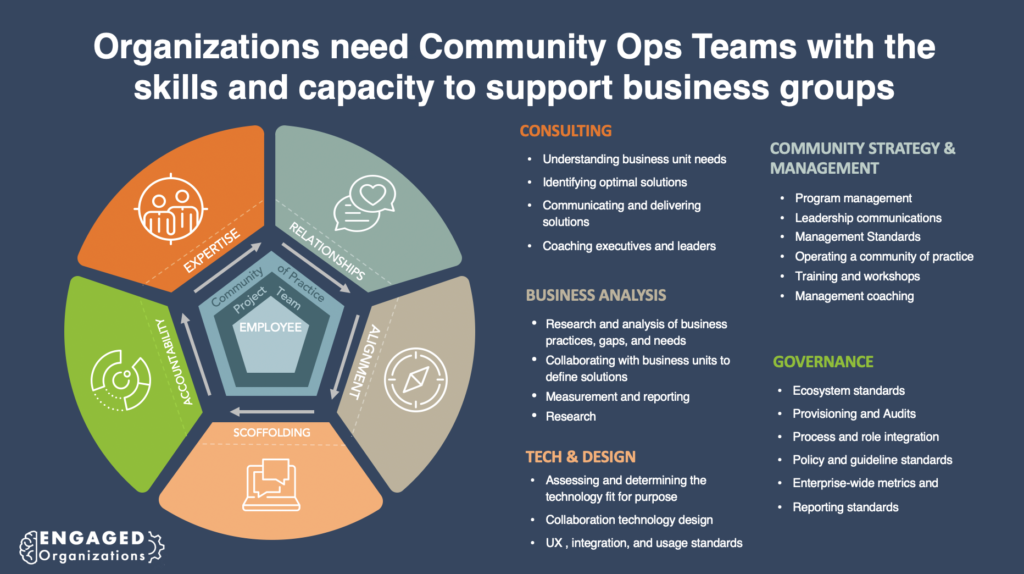
The next step executives can take is to create a team responsible for working with groups to assess their work patterns and information needs, drive consensus on where work will happen, design solutions, identify the behavior changes required, provide training, and coach the group until work behaviors consistently align with their own intentions. This is the work of Enterprise Community Teams. For those that have enterprise community teams, the 2021 State of Community Management research found that 91% of them are doing this work, although they still struggle for resources, and only 43% are formally tasked and resourced to do this work. 56% of Enterprise Community Teams get their budgets approved by C-level executives demonstrating both the strategic importance and the lack of an obvious operational functional area for them to fit into. Because there are few models to look to for guidance and the staffing required is expensive, these teams are struggling to keep up with the needs of their organizations – but they are also making headway contributing to communications efficiency, culture change, and speed of innovation.
This work is not going away – and Enterprise Community Teams are bringing a new approach to management to their organizations. One that focuses on providing some simple, clear guidance while managing the governance and culture of their group in a way that motivates and rewards individuals.
If you are interested in hearing more, have a listen to my recorded presentation for the Community Builders Summit earlier this month.
Join the conversation:
What else do you believe executives need to do to adapt their organizations to the new information environment?


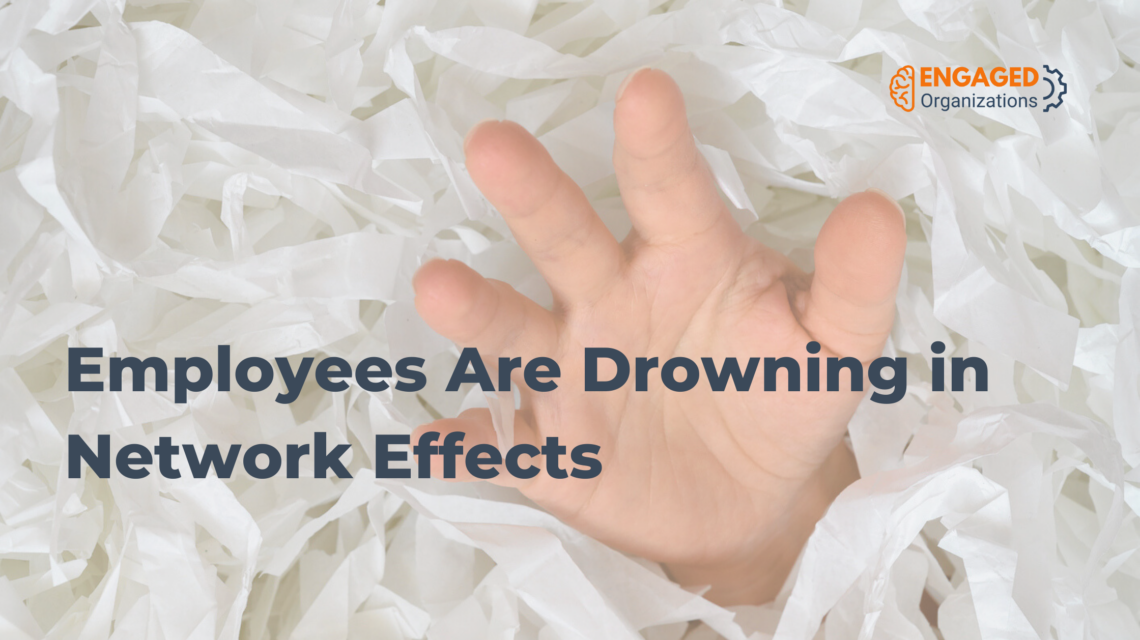
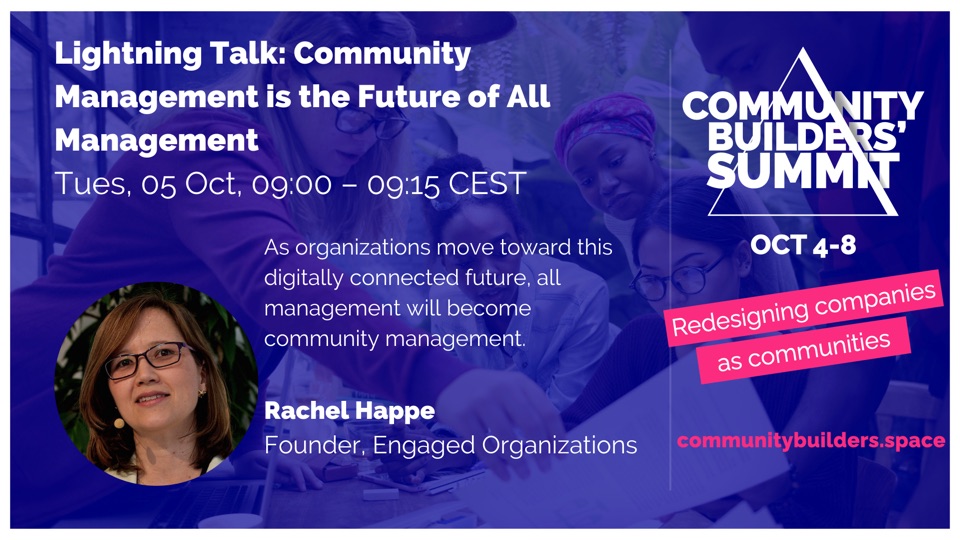
Luis Suarez
Hi, Rachel, this is quite an spectacular blog post altogether! I just couldn’t help nodding my head violently in full agreement with plenty of the reflections you have shared above. It’s pretty much mind-boggling to see how little we seem to have progressed since that epic presentation you did over a decade ago RE: people being the weakest link that I had the pleasure and real treat to attend live back in the day. Fun times!
In terms of what executives can do along the way of funding, sponsoring and actively helping Enterprise Community Teams, which I wholeheartedly agree 100% with, I would also love to offer something else, if I may, I wish would become an essential resource for organisations to dive into and apply accordingly: Harold Jarche’s PKM 👉🏻 https://jarche.com/pkm/ workshop
I just wish every single executive, their teams, and from there onwards the entire employee workforce!, would take such workshop to understand the network dynamics, the necessary digital skills & capabilities we would need to acquire and excel at, so that we can then focus on those enterprise community building programmes to thrive in this brave new world we have just entered with distributed work.
I have attended the workshop myself and the way I have been describing it to different knowledge (Web) practitioners is very adequate to the superb blog post you have put together here:
‘Personal Knowledge Mastery is where the game is in terms of the skills needed to make sense of work in a world where we are no longer remote, but distributed’.
Bring it on! Lots of great work still to be done!
Rachel Happe
That is a great addition Luis – because not only do executives have to support their employees and the work to adapt their organization, they need to really understand the changing environment and what that means for them personally, because that is key to acknowledging the issue and better understanding how to prioritize organizational investments.
I think we have made progress in the last decade but it is slow, punctuated by the hopeful distraction that the newest technology will be the magical solution. The other challenge is that breaking individuals happened slowly for a long time but in recent years has accelerated with the acceleration of content and channels – and the pandemic was the nail in the coffin for a lot of people. It was like boiling a frog slowly and easy for executives to not see – until it was very obvious. Many are now bewildered because they didn’t see it coming – but it was coming none-the-less.
Luis Suarez
I couldn’t have said it in better words, Rachel. Many thanks for taking the time to follow up on such an important and relevant conversation. I suspect we are going to start seeing a lot of chatter around Digital Leadership Enablement as it’s been an entire new industry that has *just* been discovered, when all of the foundational work has been there, readily available for a while, as you have demonstrated above.
I am seriously hoping these senior executives would go through a self-awareness exercise of where they are, along with their orgs. and perhaps find a way to shift in their narratives from that employee-centric they have been talking for a while to a whole lot more concrete actions!
Both Enterprise Community Teams and Harold’s PKM would blend quite nicely towards that direction of less blah blah blah and more contextual actions (Beyond just sponsorships and funding) to help make sense of a new-normal that’s here to stay. It’s a lovely call to action for personal agency, at all levels 😅👍🏻
Many thanks, once more, for the fantastic and inspiring article you’ve put together over here!
Let’s do it!
network literacy
[…] Employees are drowning in network effects, by @rhappe […]
Best of All Autumn
[…] “I just wish every single executive, their teams, and from there onwards the entire employee workforce!, would take such workshop to understand the network dynamics, the necessary digital skills & capabilities we would need to acquire and excel at, so that we can then focus on those enterprise community building programmes to thrive in this brave new world we have just entered with distributed work.” — Luis Suarez […]
Claudia Mayer
This is really a great article and I have also found myself nodding all the time.
While reading also the comments I was reminded of the discusssion on digital literacy the Work 4.0 community has had from 2016 into 2018.
Personal Knowledge Management to me is the core skill here.
But, imo it looks like with the pandemic digital literacy might have got out of focus. Maybe, because in the companies, (too) many people had to be brought “up-to-speed” from just a technical perspective concerning digital collaboration and community tools, while the old ways of working on all levels in a company were still prevailing by simply being translated into the digital world?
Imo, it will need a joint effort of the executives (as role model and to give their o.k.), certain functions in an organization (to offer novel opportunities to employees to train digital literacy) and each employee (who will need to understand that they will have to take action as well (as no one can expect to be carried to hunt).
How to Build a Hybrid Workplace: How Communities Transform Remote Work – Engaged Organizations
[…] is an implicit responsibility for employees to solve their communications challenges. However, because of the network effects of communications channels, it is impossible for an individual to solve. Yet organizations have largely abdicated […]
AntonioAburi
Armed with this data, you can make much smarter, better-informed decisions. Things to consider when using curation as an employee engagement strategy If you want to introduce the creation and sharing of playlists in your organization, there are several things to consider before the functionality goes live: Creation rights – who can create playlists? Does everyone automatically have the ability to do so, or is it only available to some users?
AntonioAburi
So how do you build a business case for an LXP to ensure that employee engagement is prioritized in your organization? State the problem and its measurable impact – Low employee engagement levels leads to a lack of productivity and motivation and high staff turnover rates, which is a huge business cost.